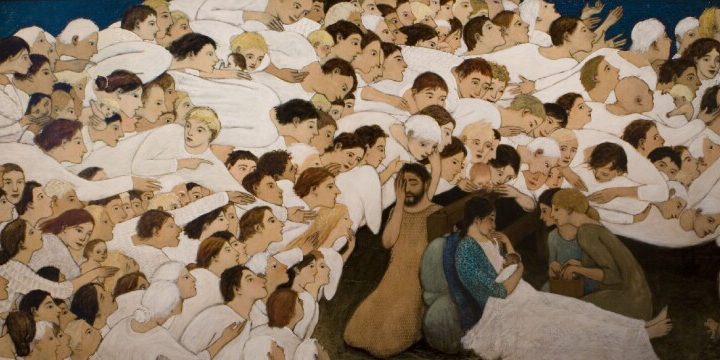Behold, a virgin shall be with child, and shall bring forth a son, and they shall call his name Emmanuel, which being interpreted is, God with us. (Matthew 1:23)
It is a commonplace observation of mainstream historical-critical New Testament scholars that the accounts of Jesus’ birth contain historically questionable and even fantastical elements. For those whose reading of the Bible is centered on questions of historicity, this creates a serious plausibility problem, which presents rather substantial belief challenges for many Christians — and preaching problems for many pastors — throughout the month of December.
A few examples suffice:
- The baby is the promised Jewish Messiah, in the line of King David, but in Matthew, that lineage is traced through Joseph, which is irrelevant, because, well, virgin birth.
- Wise men track a star over hundreds of miles to find Jesus. Their luxuriant gifts are never mentioned again, although they might have supported a family.
- Herod slays innocent children to try to kill the newborn king, and Jesus’ family has to flee to Egypt. Scholars say these elements may well be in the Gospel account in an effort to create connections to Hebrew Bible texts and motifs rather than for historical reasons. Kings in the Herodian dynasty were tyrants, but there is no record of a slaughter of children outside the account in Matthew.
- A census takes Joseph and Mary to Bethlehem, where Jesus is born, an element which may be in Luke’s account to give us a supposed fulfillment of prophecy while not denying the historical fact that Jesus was clearly raised in Galilee and launched his ministry there.

David Gushee
Of course, the central wonder in the Gospel Christmas story is the virgin birth. Some scholars have suggested this miraculous dimension entered the New Testament as a misreading of Isaiah 7:14, where “young woman” (as in RSV/NRSV) rather than “virgin” (as in most other translations) is the reading. It is also commonplace to argue that Mary-as-virgin reveals (and forever reinforces) Christian squeamishness about sex, and especially women’s sexuality, with the implicit or explicit idea that a sinless Savior could not have entered the world through sexual intercourse. Finally, it has been suggested that the story simply reflects the well-attested human tendency to mythologize the birth of religious or political heroes.
I remember sitting in a Sunday School class 30 years ago and hearing the denominational executives and professors and friends laugh together comfortably at the rubes who actually believe Jesus was born miraculously of a virgin. I didn’t like it then because it offended my more conservative theological sensibilities. I don’t like it now because I think it reflects a misbegotten way to engage the Bible.
I would therefore like to tell you about how I am believing the Christmas story this year. Not what I am believing, but how I am believing.
First: I am believing the Christmas story by entering through Advent, not just Christmas Day. My practice is to read and reflect on the daily readings offered in the Catholic liturgical calendar. In that calendar, the first Sunday of Advent (this year it was Dec. 4) marks the first day of the new church year. The church has selected dozens of texts for daily and weekly mass and associated reflection. I am reading them all, in the prescribed order.
When one engages all these readings, the broader trajectory of Jewish and Christian messianic, redemptive and eschatological hope is placed before us. This trajectory is remarkably rich and complex, and it contains many surprises. For example, the number of readings that are about political redemption, about a coming king who will rule with justice and compassion for the oppressed, is quite striking.
“This year I have been impressed by something that used to trouble me.”
This year I have been impressed by something that used to trouble me — the Christian account of Jesus as Messiah contains a paradoxical already/not yet eschatology that I now believe creates a spiritually productive, if excruciating, dynamic tension. In this story, God’s plan to redeem this broken world is decisively punctuated by the birth, life, death and resurrection of Jesus, but the world has not yet been fully redeemed. The eschaton is always out ahead of us, and yet it has been inaugurated in Jesus. We celebrate, and yet we must continue to hope for what lies ahead, a final healing of the world that is not within our control. These tensions both make sense of what I see in this world and situate my hope for and action within it.
Second: I am believing the Christmas story by focusing on and submitting to its grand narrative dimensions rather than arguing about its historical details.
Focusing: I follow the church’s direction to direct my gaze to the grand story and ponder its meanings in my heart and mind.
Submitting: Rather than placing myself above the story as historical critic, I submit to the story as it is presented to me by the Scriptures curated by the church. I am invited to enter this mystical, mysterious, compelling story, and I say yes.
Third: I am believing the Christmas story by singing it. This December I have joined a rather rigorous church choir. Given my very limited musical skills, I find myself in daily music practice under the tutelage of my very musical wife to be ready to sing the five prepared songs each week and the dozen we will sing on Christmas Eve. Engaging some of the most compelling Christian Christmas music, both old and new, is opening my heart to what the Spirit wants to say through this old, old story in an entirely surprising way.
Theologian Amos Yong has offered an account of Christian hermeneutics under the “trialectic” of Spirit-Word-Community. This is so helpful. How I am believing the Christmas story this year is by engaging it as a grateful participant in a historic Christian community — that practices a disciplined liturgical calendar — which invites engagement with Scripture as a grand narrative revealing God’s word to humanity in Jesus Christ — as experienced through the vivifying power of the Holy Spirit.
And that is a lot more meaningful than arguing about the details of the genealogy in Matthew 1.
David P. Gushee is a leading Christian ethicist. serves as distinguished university professor of Christian Ethics at Mercer University, chair of Christian social ethics at Vrije Universiteit Amsterdam, and senior research fellow at International Baptist Theological Study Centre. He is a past president of both the American Academy of Religion and the Society of Christian Ethics. His latest book is Introducing Christian Ethics. He’s also the author of Kingdom Ethics, After Evangelicalism, and Changing Our Mind: The Landmark Call for Inclusion of LGBTQ Christians. He and his wife, Jeanie, live in Atlanta. Learn more: davidpgushee.com or Facebook.
Related articles:
A case for why Mary didn’t know | Opinion by Russ Dean
Mary, Our Mother (for Baptists): Mary, did you know? | Opinion by Julia Goldie Day
This Christmastide, don’t stop with Baby Jesus | Opinion by Michael Woolf


